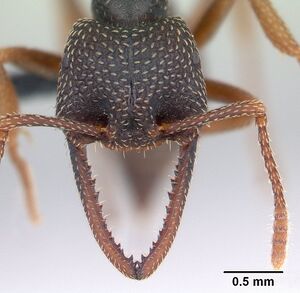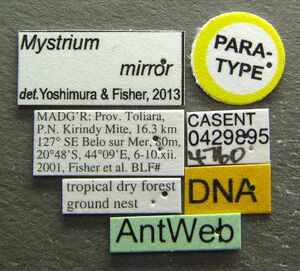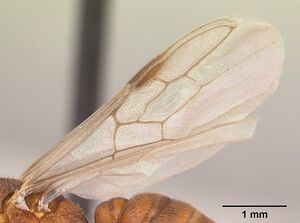The collection localities of M. mirror are in tropical dry forest, gallery forest, and spiny forest.
Identification
The worker of Mystrium mirror is distinguished from workers of other Mystrium species by the combination of a central longitudinal furrow on the pronotal dorsum, reduced convexity of the anteromedial margin of the clypeus, blunter angle between the dorsal and posterior faces of the vertex on the median line of the head, and the straight posterior declivity of the propodeum. The workers of M. mirror are quite similar to those of Mystrium shadow and Mystrium voeltzkowi, and the differences among the three species in workers are even slighter in small-sized individuals. When the comparison is made in workers within the same body size range, M. mirror can be distinguished from M. shadow by the smaller central clypeal conical setae, and from M. voeltzkowi by either the straight declivity of the propodeum and/or larger compound eye. The queen of M. mirror can be distinguished from other Mystrium queens by a combination of the mesosoma without developed wing sclerites (ergatoid), posterior face of the vertex not strongly differentiated from its dorsal face, simpler body setae, a metapleural gland bulla that is moderately developed and not expanding dorsally to the propodeal spiracle, and brighter body color. The strength of the body sculpture is remarkably variable even among members in a single colony; some individuals may lack the striae and have a shiny pronotal dorsum - this weakness or lack of striae could prove to be an additional diagnostic character to separate this species from others. The ergatoid queens that are the most similar to M. mirror are those of M. voeltzkowi and M. shadow. The less developed metapleural gland bulla separates M. mirror from M. voeltzkowi, and pronotal setae simply narrowing distally with a sharp apex separate it from M. shadow. For the males, a large eye occupying almost 75% of the lateral margin of the head in full-face view, large lateral ocelli protruding from the dorsal margin of the head in full-face view, and a shorter distance between the eye and lateral ocellus separate M. mirror and M. voeltzkowi from M. shadow. However, only genital characters can distinguish M. mirror from M. voeltzkowi.
Keys including this Species
Distribution
Latitudinal Distribution Pattern
Latitudinal Range: -13.71533° to -25.59444°.
Malagasy Region: Madagascar (type locality).
Distribution based on AntMaps
Distribution based on AntWeb specimens
Check data from AntWeb
Countries Occupied
| Number of countries occupied by this species based on AntWiki Regional Taxon Lists. In general, fewer countries occupied indicates a narrower range, while more countries indicates a more widespread species.
|

|
Estimated Abundance
| Relative abundance based on number of AntMaps records per species (this species within the purple bar). Fewer records (to the left) indicates a less abundant/encountered species while more records (to the right) indicates more abundant/encountered species.
|

|
Biology
 Explore Overview of Mystrium biology Explore Overview of Mystrium biology
|
| Mystrium are predators that specialize on capturing large centipedes. The long mandibles appear to be adapted to gripping what can be fast moving centipedes, and hold them in place to allow their being stung in the softer areas between their body segments. Foragers carrying out this task also need to have strong mandibular muscles that combined with their long mandbiles may compromise their efficiency in regards to brood care. Mystrium rogeri exhibits caste polymorphism where large workers appear to be specialized for foraging while smaller workers are adapted to specialize on brood care. Colonies of Mystrium oberthueri have large workers and many small reproductives. The vast majority of the the latter do not mate, do not leave the nest and both care for brood and are active in cleaning their nests. Colony size tends to be small (< 200 workers) and in some species, e.g., Mystrium rogeri, reproduction is based on having a single large queen morph that found nests independantly. In others, intermoph queens exist and colony founding can occur via fission.
|
|
Castes
Worker
Male
Nomenclature
The following information is derived from Barry Bolton's Online Catalogue of the Ants of the World.
- mirror. Mystrium mirror Yoshimura & Fisher, 2014: 80, figs. 5C, 8D, 20A,C,E, 24B, 25A,C, 26A,C, 27B,D, 37E, 38E, 39E, 40E, 41E, 50C, 51C, 52C, 53C, 54C, 55C, 56C (w.ergatoid q.m.) MADAGASCAR.
- Type-material: holotype worker, 5 paratype workers, 3 paratype ergatoid queens, 4 paratype males.
- Type-locality: holotype Madagascar: Toliara, Parc Nat. de Kirindy Mite, 16.3 km. 127° SE Belo sur Mer (-20.79528°, 44.147°), 80 m., 6-10.xii.2001, BLF04760, CASENT0429897 (Fisher-Griswold Arthropod Team); paratypes with same data but CASENT0429893, CASENT0429895, CASENT0429898, CASENT0429899, CASENT0318935- CASENT0318942.
- Type-depositories: CASC (holotype); BMNH, CASC, MCZC, MHNG, NHMB (paratypes).
- Distribution: Madagascar.
Unless otherwise noted the text for the remainder of this section is reported from the publication that includes the original description.
Description
Worker
Measurements: holotype. HL 1.60, HW 1.68, SL 1.19, ML 1.72, HD 1.03, WL 1.89, PnW 0.91, PpW 0.76, PtW 0.79, PtL 0.55, CI 104.7, SI 71.1, MI 102.7, PpI 83.2, PtI 143.8.
HL 1.16-1.91, HW 1.16–2.06, SL 0.94–1.48, ML 1.34–2.30, HD 0.84–1.33, WL 1.46–2.27, PnW 0.69–1.08, PpW 0.60–0.94, PtW 0.59–0.91, PtL 0.37–0.59, CI 99.5–108.3, SI 67.9–80.9, MI 103.8–115.7, PpI 81.5–92.6, PtI 143.7–163.2 (10 specimens measured).
Posterolateral corner of head strongly expanding posteriorly. Posterior face of vertex forming a blunt angle with its dorsal face on median line of head, so that declivity of vertex on lateral part distinctly steeper than on median part. Ventral half of vertex sculptured. Eye developed, relatively larger than that of M. voeltzkowi. Anterior margin of clypeus straight to weakly convex with moderately long conical setae. Genal tooth of head weakly developed, reaching or slightly exceeding basal line of lateral lobe of clypeus. Masticatory surface of mandible in full-face view visible on basal half and invisible on distal half, width of dorsal surface of mandible almost identical from mandibular shaft to distal portion. Second maxillary palpomere longer than third. First flagellomere (third antennal segment) about 1.0-1.3× length of pedicel (second antennal segment). Pronotal dorsum covered with strong and longitudinal striae, center deeply impressed. Shallow but thick longitudinal striae impressed on lateral surface of pronotum. Mesonotum differentiated from propodeum in dorsal view, length shorter than that of propodeum. Metanotal groove shallowly and gently impressed, mesonotum higher than pronotum in lateral view. Metapleural gland bulla moderately developed, propodeal declivity in lateral view almost straight. Petiole gently narrowing from anterior 1/3 in dorsal view, anterior margin straight to gently rounded and not edged by striae.
Body color reddish brown to dark brown. Four distal segments of antennal club brighter.
Queen
Ergatoid Measurements: HL 1.17–1.83, HW 1.19–1.55, SL 0.91–1.24, ML 1.12–1.50, HD 0.83–1.08, WL 1.52–2.02, PnW 0.70–0.87, PpW 0.69–0.87, PtW 0.72–0.92, PtL 0.38–0.49, CI 77.6–106.7, SI 72.0–81.9, MI 87.7– 104.0, PpI 94.0–106.6, PtI 159.5–194.5 (10 specimens measured).
Wings usually vestigial and reduced to quite small appendages; sometimes completely absent. Wing sclerites undeveloped. Posterolateral corner of head strongly to weakly expanding posteriorly, expansion relatively weaker than that of workers. Vertex usually thin, forming blunt angle between posterior and dorsal faces on median line of head, so that declivity of vertex on lateral part distinctly steeper than on median part. Ventral half of vertex sculptured, or not differentiated from dorsal region. Eye moderate and distinct. Ocelli absent. Anterior margin of clypeus straight to weakly convex with small conical setae. Genal tooth of head absent and not angled, or angled into small, short spine. Masticatory margin of mandible almost invisible in full-face view, and dorsal surface on distal portion as wide as that on mandibular shaft. Spatulate seta present on basal side of each basal denticle on masticatory margin of mandible. First flagellar segment on antenna moderately long, about 1.1-1.2× length of pedicel. Setae on pronotum almost simple, narrowing distally with strongly sharpened apex. Metapleural gland bulla moderately developed and not expanding dorsally to propodeal spiracle, so that propodeal declivity in lateral view weakly convex and rounded posteriorly on its ventral 1/3. Petiole relatively long in dorsal view, about 0.6-0.8× length of abdominal segment III.
Body color yellowish brown, brown or reddish brown.
Male
Measurements: HL 0.93–1.05, HW 1.31–1.56, SL 0.29– 0.35, EL 0.67–0.78, WL 1.90–2.38, MnW 1.23–1.40, CI 140.6–149.3, SI 21.5– 23.1, EI 70.2–74.3, MnI 88.6–94.0 (6 specimens measured).
Eye quite large, occupying about 0.75× of head length. Ocelli protruding from dorsal margin of head in full-face view. Dorsal margin of head in full-face view rounded. Both anterior and lateral ocelli large. Distance between lateral ocellus and eye equal to or shorter than diameter of lateral ocellus. Posterior face of vertex clearly differentiated from dorsal face, dorsal face distinctly shorter than posterior face. Palpal formula 4,3. First segment of maxillary palp flattened and distinctly wider than second segment. Second maxillary palpomere longer than third. Notauli shallowly and weakly impressed on mesoscutum, but often unclear. Petiole in dorsal view thin, length 0.55–0.65× that of abdominal tergite III. Petiolar dorsum covered with fine punctures. Abdominal tergum VIII without deep punctures, almost smooth.
Distal portion of abdominal sternum IX smooth and not punctured. Basal ring short, not extending basally. Telomere distinctly extending distally farther than digitus. Basoventral expansion of aedeagus well developed basoventrally, distinctly longer than dorsal extension. Ventral margin of aedeagus almost straight in lateral view. Aedeagus distinctly narrowing distally, distal portion relatively sharp.
On forewing, cu-a located at junction of Media (M) and Cubitus (Cu), or slightly to far basal from junction.
Body color yellowish to reddish brown.
Type Material
Holotype. Worker: CASENT0429897, BLF04760, MADAGASCAR, Toliara, Parc National de Kirindy Mite, 16.3 km 127° SE Belo sur Mer (-20.79528°, 44.147°), 80 m alt., 6–10.xii.2001, Fisher-Griswold Arthropod Team California Academy of Sciences.
Paratypes. 5 workers: CASENT0429898 CASC, CASENT0318935 The Natural History Museum, CASENT0318936 Musee d'Histoire Naturelle Genève, CASENT0318937 Museum of Comparative Zoology, CASENT0318938 NHMB; 3 ergatoid queens: CASENT0429899 CASC, CASENT0318939 BMNH, CASENT0318940 MHNG; 4 males: CASENT0429893 CASC, CASENT0429895 BMNH, CASENT0318941 MHNG, CASENT0318942 MCZC, with same data as holotype.
Etymology
This species name is the English word mirror, inspired by the remarkable variation displayed in this species. This species might confuse an observer as a magic mirror would, which reflects different views to the observer. The species epithet is a noun and invariant.
References
- Blaimer B. B., S. G. Brady, T. R. Schultz, and B. L. Fisher. 2015. Fucntional and phylogenetic approaches reveal the evolution of diversity in a hyper diverse biota. Ecography 38: 001-012.
- Yoshimura M., and B. L. Fisher. 2014. A revision of the ant genus Mystrium in the Malagasy region with description of six new species and remarks on Amblyopone and Stigmatomma (Hymenoptera, Formicidae, Amblyoponinae). ZooKeys 394: 1-99.





































































































